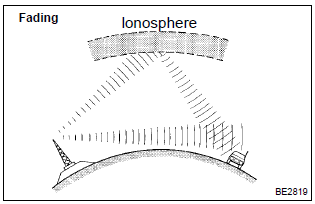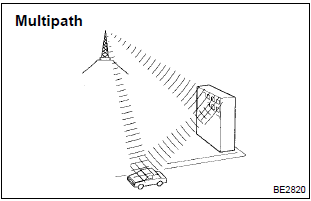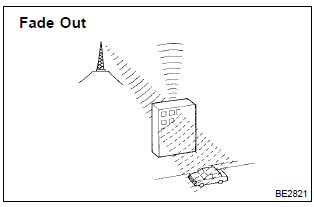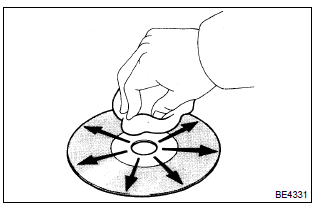Toyota Corolla (E120): Description
1. Radio wave band
The radio wave bands used in radio broadcasting are as follows:

Lf: low frequency
mf: medium frequency
hf: high frequency
vhf: very high frequency
2. Service area

- There are great differences in the size of the service area
for am and fm broadcasting. Sometimes fm stereo
broadcast cannot be received even through am can be
received very clearly.
Not only does fm stereo have the smallest service area, but it also picks up static and other types of interference (”noise”) easily.
3. Reception problems
Hint
: besides the problem of static, there are also the problems called ”fading”, ”multipath” and ”fade out”. These problems are caused not by electrical noise but by the nature of the radio waves themselves.

- Fading besides electrical interference, am broadcasts are also susceptible to other types of interference, especially at night. This is because am radio waves bounce off the ionosphere at night. These radio waves then interfere with the signals from the same transmitter that reach the vehicle’s antenna directly. This type of interference is called ”fading”.

- Multipath interference caused by reflection of radio waves against obstructions is called ”multipath”. Multipath occurs when radio signals emitted from the broadcast transmitter antenna are reflected against tall buildings or mountains and interferes with other signals which is to be received directly.

- Fade out because of the frequency higher than that of am, fm radio wave tends to be reflected against obstructions such as tall buildings or mountains. For this reason, fm signals often seems to gradually disappear or fade away as the vehicle goes behind those obstructions. This phenomenon is called ”fade out”.
4. Noise problems
- It is very important for noise troubleshooting to understand a customer’s claim clearly. Use the following table to diagnose the phenomenon.
|
Radio wave |
Condition in which noise occurs |
Probable cause |
| Am | Noise occurs at a specific place. | Strong possibility of foreign noise. |
| Noise occurs when listening to faint broadcasting. | The same program may be broadcasted from some local stations.
If the program is the same, one of those may be tuned in. |
|
| Fm | Noise occurs only at night. | Strong possibility of beat from a distant broadcasting. |
| Noise occurs at a specific place during driving. | Strong possibility of multipath noise and fading noise caused by changes of fm frequency. |
Hint
: if the condition where the noise occurs does not meet any of the above, find out the cause based on ”reception problems”. Refer to the description about multipath and fading mentioned previously. 5. Compact disc player
- compact disc (hereafter called ”cd”) players use a laser beam pick–up to read the digital signals recorded on the cd and reproduce analog signals of the music, etc. There are 4.7 In. (12 Cm) and 3.2 In. (8 Cm) discs available for the cd player.
Hint
: never attempt to disassemble or oil any part of the player unit. Do not insert any object other than a disc into the magazine.
Notice
: cd players use an invisible laser beam which could cause hazardous radiation exposure. Be sure to operate the player correctly as instructed.
6. Maintenance

Tape player/head cleaning:
- raise the cassette door with your finger.
Using a pencil or similar object, push in the guide.
- using a cleaning pen or cotton applicator soaked in cleaner, clean the head surface, pinch rollers and capstans.
7. Maintenance

Cd player/disc cleaning:
If the disc gets dirty, clean the disc by wiping the surface from the center to outside in the radial directions with a soft cloth.
Notice
: do not use a conventional record cleaner or anti–static preservative.
8. Communication system
- components in the audio system communicate each other though avc–lan.
- the master component of avc–lan is the radio receiver assy with a resistance (60 – 80 w), which is necessary for communication.
- when short circuit or circuit breakdown occurs in the avc–lan circuit, the audio system does not operate normally due to the communication cutoff.
9. Diagnosis function
- the audio system has diagnosis function (the diagnosis result is displayed on the lcd of the radio receiver assy).
- the component code (physical address), or three–digit number (in hexadecimal) is set for each component comprising avc–lan.
- the logical address, or two–digit number (in hexadecimal) is set for each function and component unit in each component.
Other materials:
Basic inspection
Resistance measuring condition of electronic parts
unless stated, all resistance is measured at an ambient
temperature of 20 c (68 °F). As the resistance
may be outside the specifications if measured at high temperatures
immediately after
the vehicle has been running, measu ...
Monitor description
While the engine is being cranked, the battery positive voltage is applied to
terminal sta of the ecm.
If the ecm detects the starter control signal (sta) while the vehicle is
driving, it will conclude that there is
a fault in the starter control circuit. The ecm will turn on the mil and a d ...
Deleting a registered phone number
1 Select “Delete contacts” using .
2 Select the desired phone number using
and press
(YES).
To delete all of the registered phone numbers, select “All delete” using
and press
(YES). ...


